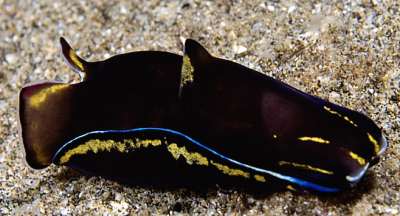
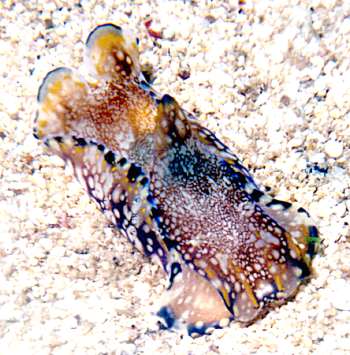
Philinopsis speciosa
Pease, 1860
Order: CEPHALASPIDEA
Superfamily: PHILINOIDEA
Family: Aglajidae
PHOTO
Upper: Ulua Beach, Wailea, Hawaii (Maui). Depth: 40-50 ft. 05 and 06 May 2005. Sand. Photographer: Mike Roberts. Lower: Pupukea, Oahu, Hawaii, USA. Locality: Depth: 10 m. Length: 25-50 mm. Mixture of coral and basaltic sand. Photographer: Scott Johnson
Philinopsis speciosa was first reported from Hawaii. The original description of this species, the type of the genus Philinopsis, records the external features and the color:
"Colour above- fawn, spotted and speckled with white; margins more or less varied with blackish and yellow; sides paler. Foot purplish fawn, and closely freckled with whitish, and broadly margined on both sides with the dorsal colours intermixed."
From colour photographs now available, the colour description can be extended. The ground colour of the animal ranges from light translucent brown to an opaque dark brown or even black. There are a pair of yellow to orange-brown parallel lines on the headshield on either side of the midline, and sometimes traces of a second line on each side, further out, similar to those sometimes present in P. cyanea. The white spots range from quite small to very large, the large white markings being somewhat broken by brown speckling. The margin of the parapodia is colored with black, blue and orange-yellow markings, which can sometimes form lines. The foot appears to be of similar colour to the dorsal surface. The colour is extremely variable, and parts of the pattern can be absent in any specimen.
From an earlier investigation (Rudman, 1972a) I can say there are no anatomical features distinguishing P. speciosa from the widespread Philinopsis cyanea, a species which is widespread throughout the Indo-West Pacific and shows an identical range of colour variation. In that earlier study I did not know there was a black colour form and so accepted the prevailing view that P. speciosa was endemic to the Hawaiian Islands, a species with similarities in colour to the SE Pacific Philinopsis taronga and the NE Pacific species P. gigliolii.
It would appear that P. speciosa is a widespread Indo-West Pacific species which has been identified in most places as P. cyanea. As P. speciosa is the older name, and the type of the genus, it should replace the more commonly used P. cyanea.
The position is probabl;y more complicated. I am not quite sure what we should do with Philinopsis depicta from the Mediterranean. I have long felt it was probably the same species as the Indo-West Pacific P. cyanea [or rather P. speciosa]. In fact the two photos on the P. depicta Fact Sheet are almost identical to the two colour forms of Philinopsis speciosa illustrated here from Hawaii. There also appear to be no major anatomical differences. If we accept that P. depicta also occurs in the Caribbean [see messages #9570 , #14642], perhaps we have here a single species with a circumglobal distribution, like Hydatina physis and Micromelo undata?
-
Pease, W.H. (1860) Descriptions of new species of Mollusca from the Sandwich Islands. Proceedings of the Zoological Society of London 28, 18-36.
-
Rudman,W.B. (1972a) A comparative study of the genus Philinopsis Pease, 1860 (Aglajidae, Opisthobranchia). Pacific Science, 26: 381-399.
-
Rudman,W.B. (1972b) Structure and functioning of the gut in the Bullomorpha (Opisthobranchia). Journal of Natural History, 6: 547-560.
Rudman, W.B., 2006 (February 3) Philinopsis speciosa Pease, 1860. [In] Sea Slug Forum. Australian Museum, Sydney. Available from http://www.seaslugforum.net/find/philspec
Related messages
Philinopsis speciosa from Maui, Hawaii
July 27, 2006
From: Jim Spears
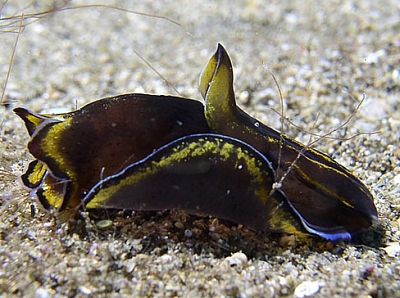
Please ID the specimen in the attached photo.
There were approximately 10 to 12 of these animals in a small area of a sandy bottom. Some had the yellow coloring with blue edging and some had only the blue edging.
Locality: Wailea, Maui, 50, Hawaii, Pacific, 19 July 2006, sandy bottom. Length: 1 to 1 and 1/2 inches. Photographer: Jim Spears.
Thank you.
Jim
jim@kayakdiver.com
Spears, J., 2006 (Jul 27) Philinopsis speciosa from Maui, Hawaii. [Message in] Sea Slug Forum. Australian Museum, Sydney. Available from http://www.seaslugforum.net/find/17189Dear Jim,
This is Philinopsis speciosa. As you will see from the earlier messages, this species is quite varaible in colour, so it is good to get a photo showing another colour variation
Best wishes,
Bill Rudman
Re: More on Hawaiian Philinopsis speciosa [2]
February 6, 2006
From: Terry Gosliner
Concerning message #15674:
Hi Bill,
I have collected specimens of Philinopsis speciosa from Hawaii and, like Cory, have found light and dark colored individuals together and have observed them mating. I also have dissected specimens and can find no difference anatomically between P. speciosa and P. cyanea. I am pretty convinced they are synonyms.
Terry
tgosliner@calacademy.org
Gosliner, T., 2006 (Feb 6) Re: More on Hawaiian Philinopsis speciosa [2]. [Message in] Sea Slug Forum. Australian Museum, Sydney. Available from http://www.seaslugforum.net/find/15752Thanks Terry,
Bill Rudman
More on Hawaiian Philinopsis speciosa [2]
February 4, 2006
From: Cory Pittman
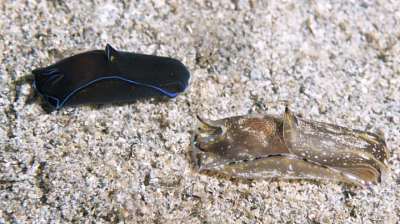

Concerning message #15635:
Dear Bill,
I see Scott already sent you some photos of the light phase of Philinopsis speciosa. However, last fall John Hoover sent me a nice shot of the two main color phases crawling together that I'm attaching (with his permission). I don't have all the info for it but it was taken on Oahu in September, 2005.
Locality: Oahu, Hawaii, USA. September 2005. on sand. Photographer: John Hoover
Best wishes,
Cory Pittman
cory@cet.com
Pittman, C. C., 2006 (Feb 4) More on Hawaiian Philinopsis speciosa [2]. [Message in] Sea Slug Forum. Australian Museum, Sydney. Available from http://www.seaslugforum.net/find/15674Thanks Cory,
I am going to be very cautious and put all the Hawaiian records as P. speciosa and leave the others as P. cyanea and hope I receive some feedback.
Best wishes,
Bill Rudman
More on Hawaiian Philinopsis speciosa [1]
February 4, 2006
From: Cory Pittman
Concerning message #15635:
Dear Bill,
On Maui, Philinopsis speciosa is fairly common both in Halimeda incrassata beds at depths over 10 m and in shallower, mixed sand/rubble habitats at moderately protected to moderately exposed sites. Its appearance and behavior seem quite consistent with P. cyanea on the Forum and I've thought of them as probable synonyms for some time. My one reservation about lumping them derives from an observation I made back in 1995. A 55 mm animal collected from a tide pool at Napili Bay, Maui on September 8 laid eggs while I was holding it in an aerated container. The mass measured 65 mm by 17 mm and was of the typical form for the species. However, there were only 7-10 eggs per capsule. This contrasts with Philibert Bidgrain's report of P. cyanea from Reunion of 20-30 eggs per capsule. I don't know whether or not this is significant but I thought it might be of interest. Sorry, no photo (I think my camera was "down" for some reason).
Locality: Napili Bay, Maui, Hawaii, USA. tide pool. Length: 55 mm. 8 September 1995. pool with cobble bottom over coarse sand
Best wishes,
Cory Pittman
cory@cet.com
Pittman, C. C., 2006 (Feb 4) More on Hawaiian Philinopsis speciosa [1]. [Message in] Sea Slug Forum. Australian Museum, Sydney. Available from http://www.seaslugforum.net/find/15673Thanks Cory,
I think it is always more difficult to 'lump' two species together than it is to erect a new species. I am not sure if that range in eggs per capsule is important in this group. I would welcome some more input if anyone has information to add.
Best wishes,
Bill Rudman
Philinopsis speciosa from Hawaii
January 26, 2006
From: Scott Johnson
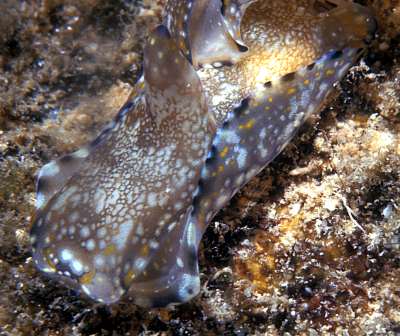
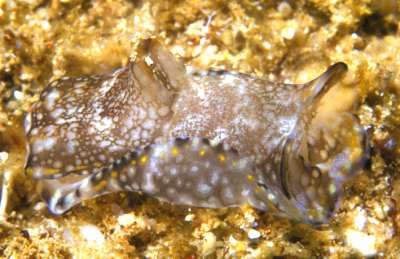
Concerning message #15635:
Hi Bill,
Here are three shots of Philinopsis speciosa from Hawaii. I saw these rarely during the late 1970s, but usually if I saw any at all, I would see several on a single dive.
Locality: Pupukea, Oahu, Hawaii, USA. Locality: Depth: 10 m. Length: 25-50 mm. Mixture of coral and basaltic sand. Photographer: Scott Johnson
Scott
uwkwaj@yahoo.com
Johnson, S., 2006 (Jan 26) Philinopsis speciosa from Hawaii. [Message in] Sea Slug Forum. Australian Museum, Sydney. Available from http://www.seaslugforum.net/find/15649
Dear Scott,
I remember now that my hesitation in synonymising P. cyanea with P. speciosa in 1972 was based on the similarity of this white-spotted colour form to New Zealand specimens of Philinopsis taronga and the NE Pacific species P. gigliolii. Now I wonder if they are all temperate forms of one widespread species.
Leaving them aside, your animals from Hawaii, and Mike Roberts photo of dark form [#14082] suggest that the whole range of colour variation is found in Hawaii. Considering I could find no significant anatomical differences between Hawaiian specimens of P. speciosa and Indian Ocean specimens of P. cyanea [see Rudman, 1972] it seems there are no reasons to consider them distinct species. Some will say we should try and use the International Rules to suppress the older, but relatively unused name, Philinopsis speciosa, but as it is the type species of the genus, we can hardly call it unused.
I am not quite sure what we should do with Philinopsis depicta from the Mediterranean. I have long felt it was probably the same species as the Indo-West Pacific P. cyanea [or rather P. speciosa]. In fact the two photos on the P. depicta Fact Sheet are almost identical to the two colour forms of Philinopsis speciosa illustrated from Hawaii here in the message from Scott Johnson and in Mike Roberts's [#14082]. There also appear to be no major anatomical differences. If we accept that P. depicta also occurs in the Caribbean [see messages #9570 , #14642], perhaps we have here a single species with a circumglobal distribution, like Hydatina physis and Micromelo undata?
Best wishes,
Bill Rudman
Re: Aggregation of Stylocheilus striatus in Indonesia
January 24, 2006
From: Clay Carlson
Concerning message #15629:
It looks like Philinopsis cyanea (Martens, 1879), is a junior synonym of P. speciosa (Pease, 1860). The description given in Rudman, 1972: 389 for P. speciosa pretty well matches what is shown here as P. cyanea.
-
Rudman,W.B., 1972. A comparative study of the genus Philinopsis Pease, 1860 (Aglajidae, Opisthobranchia). Pacific Science, 26: 381-399.
Clay Carlson
ccarlson@guam.net
Carlson, C & Hoff, P-J., 2006 (Jan 24) Re: Aggregation of Stylocheilus striatus in Indonesia. [Message in] Sea Slug Forum. Australian Museum, Sydney. Available from http://www.seaslugforum.net/find/15635Dear Clay,
Who am I to disagree with Rudman? Certainly Pease's description and Alison Kay's photos are very similar to P. cyanea, and the anatomy of specimens from Hawaii that I studied showed no differences to that species. At that stage I tended to respect the views of Hawaiian biologists who believed there was considerable endemism in the fauna. I think today I would have had little hesitation in considering the two species to be the same.
I don't know why Mike Roberts' message [#14082] of a Philinopsis feeding on Stylocheilus in Hawaii didn't jog my memory. Unfortunately the copy slides Alison Kay sent me have faded so I can't compare the colour of Hawaiian specimens. If anyone has photos showing colour forms of Philinopsis speciosa or P. cyanea from Hawaii, they would be very welcome.
Best wishes,
Bill Rudman
Philinopsis cyanea hunting Stylocheilus
June 20, 2005
From: Mike Roberts
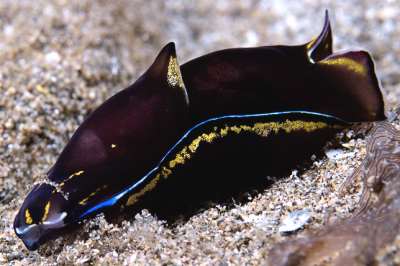
To accompany my message [#14074] on Stylocheilus swarming in Hawaii, here are some photos of one of the predators I observed eating them.
Locality: Ulua Beach, Wailea, Hawaii (Maui). Depth: 40-50 ft. 05 and 06 May 2005. Sand. Photographer: Mike Roberts
There were literally thousands upon thousands of Stylocheilus forming rivers of slugs climbing on top of each other with a definite plan of going south.On an even closer inspection the individual slugs could be spotted in all sizes from large - for a sea hare anyway - to those that seem freshly hatched.Cute little guys but they were the hors deuvres of the day. Stripebelly puffer fish just rested next the line of food, looking like so many Jabas while gorging themselves well beyond capacity.
Then I saw a nudi I had never seen before. He was a mean machine with body lines that would make Fisher jealous. He was certainly built for speed! This efficient little machine was just zooming along in haphazard patterns until he caught the "scent" of a hare in his path. Then, without missing a beat, the hare would be sucked into his powerful manifold and he would move on to the next one.
Even though there were dozens of these sleek nudis driving around in circles and slurping up the little morsels, even though the puffers stationed along the rivers were too fat to swim, the hares didn't seem to understand they were lunch. But it didn't matter in the big scheme. They had numbers on their side. And they just kept marching south.
Mike Roberts
mike@tortuga-web.com

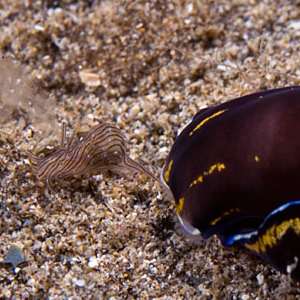

Dear Mike,
Thanks for this great observation - and your graphic description of it. The white lines at the front of the head ar on a swelling on each side of the mouth which is covered in sensory bristles which sense the mucous in the trails of their prey. They have no teeth so they feed by partially everting their large muscular buccal bulb and by a combination of suction and envelopment drag their prey into their large sac like crop, where it is digested. Your description of the puffer fish and Philinopsis lurking around the edge of the mass of Sea Hares reminds me of the the lions and hyaenas picking off prey during the mass migrations of herbivores in the grasslands of East Africa - but I hasten to add that this isn't proof that what we are seeing is a migration.
Best wishes,
Bill Rudman
